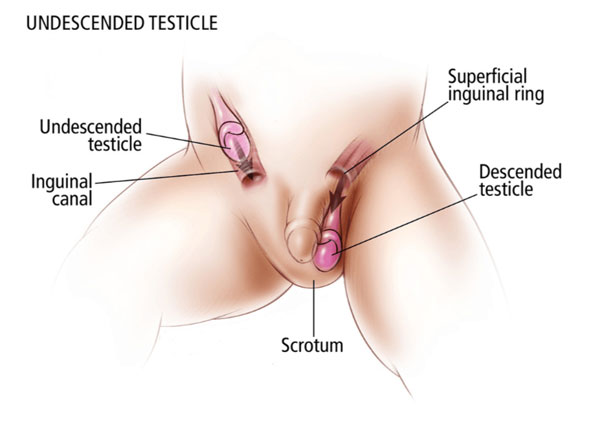Undescended Testis In Children
What is cryptorchidism (Undescended Testes)?
Cryptorchidism (or undescended testes) is a neonatal disorder in which one or both male testes have not gone down into the scrotal sac.
Undescended testes are more common in preterm neonates than in full-term babies. Fortunately, only around 1% of males need treatment since the testicles often drop as newborns grow and mature.
Bilateral cases account for about 10% of all cases (involving both testes). Because the testes do not descend from the abdomen to the scrotal sac until the seventh month of fetal development, cryptorchidism is more likely in preterm babies.

What causes undescended testes?
While preterm is the most common cause, other factors such as hormonal abnormalities, spina bifida, retractile testes, or testicular absence may also be a factor.
What are the symptoms of undescended testicles?
Most babies and children with this condition have no symptoms. The only sign is that the scrotum is empty.
Who is affected by undescended testes?
- According to pediatric urologists, roughly 3 to 5% of male babies have undescended testes.
- An undescended testis affects up to one-third of preterm male babies.
- There is also a genetic component: 14 percent of males with undescended testes also had a male relative with the condition.
- Boys who have an inguinal hernia repaired may acquire undescended testes in rare situations.
Diagnosis
Repeated testicular inspection is the initial step in diagnosing undescended testes.
Laparoscopy and, in rare situations, imaging such as ultrasonography are further diagnostic methods. The severity of the condition ranges from mild to severe:
- Retractile testes are a natural reflex of the testicles to relocate to places where they cannot be seen or felt on subsequent physical examinations.
- Ascended testes are a progressive upward movement of the testicles that occurs during and after childhood. Testicles may be felt on the test, but they move higher with each consecutive exam.
- Undescended, palpable testes indicate that the testicle is not visible but may be touched during physical examinations.
- Undescended, non-palpable testes occur when the testicles cannot be seen or felt on a physical exam.
Undescended Testis Treatment
There are two types of treatment: hormonal and surgical.
Hormonal therapy
In cases in which both sides are undescended, hormonal treatment may aid the testicles’ descent into the scrotum. Human chorionic gonadotropin (hCG) is administered as an injection over a period of several weeks. It treats undescended testes around 10% to 15% of the time. Surgery might still be required.
Surgery
Depending on the placement of the testicle and the distance to the scrotal sac, there are many methods that may be used to address this issue.
Orchiopexy is an outpatient treatment that involves general anesthesia (the patient does not need to remain in the hospital). When the surgeon feels the testicle in the groin, this procedure is performed. The testicle is found, liberated from limiting tissues, positioned, and fixed in the scrotum through a small incision in the groin. The passageway is then stitched closed to prevent re-ascent.
Laparoscopic orchidopexy surgery is commonly done when the testicle cannot be felt on physical examination. The testicle may be in the abdomen, may be absent, or very small. It may have twisted sometime prior to the child’s birth and lost its blood supply. The remaining non-functional tissue is removed during surgery. To avoid testicular torsion, the other testicle is anchored in its scrotal sac. After adolescence, a prosthesis (an artificial substitute) may be put in the scrotum if the deformed testicle is removed.
For more information & consultation on Undescended Testis in Children, Get in touch with Dr. Adwait Prakash a Pediatric Surgeon in Indore. will help you out in understanding your problem and guide you through every stage of your treatment.
To book your appointment Call: 8889588832.
